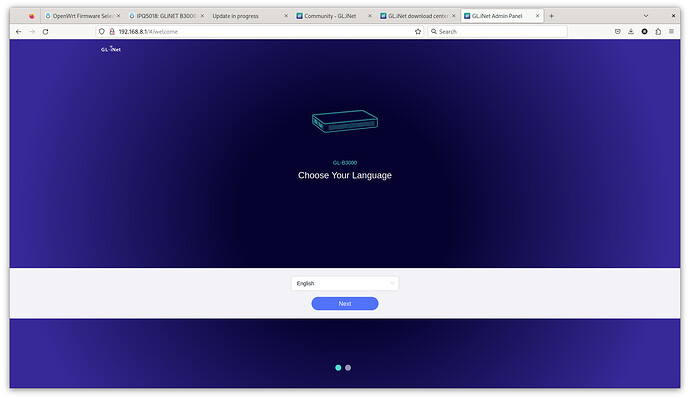Ok , i think I edited the dts in the build directory but never updated the dts in the src before pushing the code.
use this dts for now
/dts-v1/;
#include "ipq5018.dtsi"
#include "ipq5018-ess.dtsi"
#include <dt-bindings/gpio/gpio.h>
#include <dt-bindings/input/input.h>
/ {
model = "GL.iNet B3000, Inc. IPQ5018/AP-MP03.5-C1";
compatible = "b3000", "glinet,gl-b3000", "qcom,ipq5018-ap-mp03.5-c1", "qcom,ipq5018-mp03.5", "qcom,ipq5018";
interrupt-parent = <&intc>;
aliases {
serial0 = &blsp1_uart1;
ethernet0 = &dp1;
ethernet1 = &dp2;
label-mac-device = &dp2;
led-boot = &led_system_blue;
led-failsafe = &led_status_white;
led-running = &led_status_white;
led-upgrade = &led_system_blue;
};
chosen {
bootargs-append = " root=/dev/ubiblock0_1 swiotlb=1 coherent_pool=2M";
stdout-path = "serial0:115200n8";
};
leds {
compatible = "gpio-leds";
pinctrl-0 = <&leds_pins>;
pinctrl-names = "default";
led_system_blue: led_system_blue {
label = "led_system_blue";
gpio = <&tlmm 24 0>;
default-state = "on";
};
led_status_white: led_status_white {
label = "led_status_white";
gpio = <&tlmm 23 0>;
default-state = "off";
};
};
keys {
compatible = "gpio-keys";
pinctrl-0 = <&button_pins>;
pinctrl-names = "default";
button_reset {
label = "reset";
gpios = <&tlmm 27 GPIO_ACTIVE_LOW>;
linux,input-type = <EV_KEY>;//<1>;
linux,code = <KEY_RESTART>;
debounce-interval = <60>;
};
};
reserved-memory {
tz_appps@4a400000 {
no-map;
reg = <0x0 0x4a400000 0x0 0x400000>;
};
q6_mem_regions: q6_mem_regions@4b000000 {
no-map;
reg = <0x0 0x4b000000 0x0 0x3000000>;
};
};
};
&switch {
status = "okay";
switch_mac_mode = <MAC_MODE_SGMII_CHANNEL0>;
qcom,port_phyinfo {
// MAC0 -> GE Phy -> QCA8337 Phy2
port@0 {
port_id = <1>;
mdiobus = <&mdio0>;
phy_address = <7>;
phy_dac = <0x10 0x10>;
// status = "disabled";
};
// MAC1 ---SGMII---> QCA8337 SerDes
port@1 {
port_id = <2>;
forced-speed = <1000>;
forced-duplex = <1>;
};
};
};
// MAC0 -> GE Phy
&dp1 {
/*
* ===============================================================
* _______________________ _______________________
* | IPQ5018 | | QCA8337 |
* | +------+ +--------+ | | +--------+ +------+ |
* | | MAC0 |---| GE Phy |-+--UTP--+-| Phy4 |---| MAC5 | |
* | +------+ +--------+ | | +--------+ +------+ |
* | +------+ +--------+ | | +--------+ +------+ |
* | | MAC1 |---| Uniphy |-+-SGMII-+-| SerDes |---| MAC0 | |
* | +------+ +--------+ | | +--------+ +------+ |
* |_______________________| |_______________________|
*
* ===============================================================
*
* Current drivers don't support such topology. So dp1 and ge_phy
* are useless. But they can't be disabled due to qca-ssdk use
* ge_phy to detect IPQ5018 dummy switch.
*/
status = "okay";
};
// MAC1 ---SGMII---> QCA8337 SerDes
&dp2 {
status = "okay";
phy-mode = "sgmii";
nvmem-cells = <&macaddr_dp2>;
nvmem-cell-names = "mac-address";
fixed-link {
speed = <1000>;
full-duplex;
};
};
&mdio0 {
status = "okay";
};
// IPQ5018 GE Phy -> QCA8337 Phy1
&ge_phy {
status = "okay";
};
&mdio1 {
status = "okay";
pinctrl-0 = <&mdio1_pins>;
pinctrl-names = "default";
reset-gpios = <&tlmm 39 GPIO_ACTIVE_LOW>;
// QCA8337 Phy0 -> WAN
qca8337_0: ethernet-phy@0 {
reg = <0>;
};
// QCA8337 Phy1 -> LAN1
qca8337_1: ethernet-phy@1 {
reg = <1>;
};
// QCA8337 Phy3 -> LAN2
qca8337_2: ethernet-phy@2 {
reg = <2>;
};
// QCA8337 Phy2 -> IPQ5018 GE Phy
qca8337_3: ethernet-phy@3 {
reg = <3>;
};
// QCA8337 Phy4 -> LAN3
qca8337_4: ethernet-phy@4 {
reg = <4>;
};
// QCA8337 switch
switch1: ethernet-switch@17 {
compatible = "qca,qca8337";
reg = <17>;
#address-cells = <1>;
#size-cells = <0>;
//switch_cpu_bmp = <0x40>; /* cpu port bitmap */
//switch_lan_bmp = <0x0c>; /* lan port bitmap */
//switch_wan_bmp = <0x02>; /* wan port bitmap */
ports {
#address-cells = <1>;
#size-cells = <0>;
// QCA8337 Phy0 -> WAN
port@1 {
reg = <1>;
label = "wan";
phy-handle = <&qca8337_0>;
port_id = <1>;
phy_address = <0>;
};
// QCA8337 Phy1 -> LAN1
port@2 {
reg = <2>;
label = "lan1";
phy-handle = <&qca8337_1>;
port_id = <2>;
phy_address = <1>;
};
// QCA8337 Phy3 -> LAN2
port@3 {
reg = <3>;
label = "lan2";
phy-handle = <&qca8337_2>;
port_id = <3>;
phy_address = <2>;
};
// QCA8337 Phy2 -> IPQ5018 GE Phy
port@4 {
reg = <4>;
label = "cpu1";
phy-handle = <&qca8337_3>;
port_id = <4>;
phy_address = <3>;
status = "disabled";
};
// N/A
port@5 {
reg = <5>;
label = "lan3";
phy-handle = <&qca8337_4>;
status = "disabled";
};
port@6 {
reg = <6>;
label = "cpu";
phy-mode = "sgmii";
ethernet = <&dp2>;
qca,sgmii-enable-pll;
fixed-link {
speed = <1000>;
full-duplex;
};
};
};
};
};
&sleep_clk {
clock-frequency = <32000>;
};
&xo_board_clk {
clock-frequency = <24000000>;
};
&blsp1_uart1 {
status = "okay";
pinctrl-0 = <&blsp_uart0_pins>;
pinctrl-names = "default";
};
&crypto {
status = "okay";
};
&cryptobam {
status = "okay";
};
&prng {
status = "okay";
};
&qfprom {
status = "okay";
};
&qpic_bam {
status = "okay";
};
&qpic_nand {
pinctrl-0 = <&qpic_pins>;
pinctrl-names = "default";
status = "okay";
partitions {
status = "disabled";
};
nand@0 {
compatible = "spi-nand";
reg = <0>;
#address-cells = <1>;
#size-cells = <1>;
nand-ecc-engine = <&qpic_nand>;
nand-ecc-strength = <8>;
nand-ecc-step-size = <512>;
nand-bus-width = <8>;
partitions {
compatible = "fixed-partitions";
#address-cells = <1>;
#size-cells = <1>;
partition@0 {
label = "0:SBL1";
reg = <0x00000000 0x80000>;
read-only;
};
partition@80000 {
label = "0:MIBIB";
reg = <0x00080000 0x80000>;
read-only;
};
partition@100000 {
label = "0:BOOTCONFIG";
reg = <0x00100000 0x40000>;
read-only;
};
partition@140000 {
label = "0:QSEE";
reg = <0x00140000 0x100000>;
read-only;
};
partition@240000 {
label = "0:DEVCFG";
reg = <0x00240000 0x40000>;
read-only;
};
partition@280000 {
label = "0:CDT";
reg = <0x00280000 0x40000>;
read-only;
};
partition@2c0000 {
label = "0:APPSBLENV";
reg = <0x002c0000 0x80000>;
};
partition@340000 {
label = "0:APPSBL";
reg = <0x00340000 0x140000>;
read-only;
};
partition@480000 {
label = "0:ART";
reg = <0x00480000 0x100000>;
read-only;
nvmem-layout {
compatible = "fixed-layout";
#address-cells = <1>;
#size-cells = <1>;
macaddr_dp2: macaddr@0 {
reg = <0x0 0x6>;
};
};
};
partition@580000 {
label = "0:TRAINING";
reg = <0x00580000 0x80000>;
read-only;
};
partition@600000 {
label = "CFG";
reg = <0x00600000 0x200000>;
};
partition@800000 {
label = "rootfs";
reg = <0x00800000 0x7800000>;
};
};
};
};
&tlmm {
mdio1_pins: mdio-state {
mdc-pins {
pins = "gpio36";
function = "mdc";
drive-strength = <8>;
bias-pull-up;
};
mdio-pins {
pins = "gpio37";
function = "mdio";
drive-strength = <8>;
bias-pull-up;
};
};
leds_pins: leds_pins {
led_system_blue {
pins = "gpio24";
function = "gpio";
drive-strength = <8>;
bias-pull-down;
};
led_status_white {
pins = "gpio23";
function = "gpio";
drive-strength = <8>;
bias-pull-down;
};
};
button_pins: button_pins {
button_reset {
pins = "gpio27";
function = "gpio";
drive-strength = <8>;
bias-pull-up;
};
};
qpic_pins: qpic-state {
clock-pins {
pins = "gpio9";
function = "qspi_clk";
drive-strength = <8>;
bias-disable;
};
cs-pins {
pins = "gpio8";
function = "qspi_cs";
drive-strength = <8>;
bias-disable;
};
data-pins {
pins = "gpio4", "gpio5", "gpio6", "gpio7";
function = "qspi_data";
drive-strength = <8>;
bias-disable;
};
};
blsp_uart0_pins: blsp_uart0_pins {
pins =
"gpio20", // RX
"gpio21"; // TX
function = "blsp0_uart0";
drive-strength = <8>;
bias-disable;
};
};
&tsens {
status = "okay";
};
&pcie_x2phy {
status = "disabled";
};
&pcie_x2 {
status = "disabled";
perst-gpios = <&tlmm 15 GPIO_ACTIVE_LOW>;
};
&q6v5_wcss {
status = "okay";
memory-region = <&q6_mem_regions>;
firmware-name = "ath11k/IPQ5018/hw1.0/q6_fw.mdt",
"ath11k/IPQ5018/hw1.0/m3_fw.mdt",
"ath11k/qcn6122/hw1.0/m3_fw.mdt";
/*TODO: add support for v1 bootargs in mpd driver to control below settings*/
/*qcom,bootargs_smem = <507>; hard-coded in mpd driver */
/*boot-args = < */
/* type: 0x1 PCIE0 */
/* length: 4 */
/* PD id: 3 */
/* reset GPIO: 15 */
/* reserved: 0 0>; */
/* driver currently doesn't support passing bootargs */
// IPQ5018
q6_wcss_pd1: pd-1 {
firmware-name = "ath11k/IPQ5018/hw1.0/q6_fw.mdt";
resets =
<&gcc GCC_WCSSAON_RESET>,
<&gcc GCC_WCSS_BCR>,
<&gcc GCC_CE_BCR>;
reset-names =
"wcss_aon_reset",
"wcss_reset",
"ce_reset";
clocks =
<&gcc GCC_WCSS_AHB_S_CLK>,
<&gcc GCC_WCSS_ACMT_CLK>,
<&gcc GCC_WCSS_AXI_M_CLK>;
clock-names =
"gcc_wcss_ahb_s_clk",
"gcc_wcss_acmt_clk",
"gcc_wcss_axi_m_clk";
// qcom,halt-regs = <&tcsr_q6_block 0xa000 0xd000 0x0>;
interrupts-extended =
<&wcss_smp2p_in 8 0>,
<&wcss_smp2p_in 9 0>,
<&wcss_smp2p_in 12 0>,
<&wcss_smp2p_in 11 0>;
interrupt-names =
"fatal",
"ready",
"spawn-ack",
"stop-ack";
qcom,smem-states =
<&wcss_smp2p_out 8>,
<&wcss_smp2p_out 9>,
<&wcss_smp2p_out 10>;
qcom,smem-state-names =
"shutdown",
"stop",
"spawn";
status = "okay";
};
// QCN6102 6G
q6_wcss_pd2: pd-2 {
firmware-name = "ath11k/IPQ5018/hw1.0/q6_fw.mdt";
interrupts-extended =
<&wcss_smp2p_in 16 0>,
<&wcss_smp2p_in 17 0>,
<&wcss_smp2p_in 20 0>,
<&wcss_smp2p_in 19 0>;
interrupt-names =
"fatal",
"ready",
"spawn-ack",
"stop-ack";
qcom,smem-states =
<&wcss_smp2p_out 16>,
<&wcss_smp2p_out 17>,
<&wcss_smp2p_out 18>;
qcom,smem-state-names =
"shutdown",
"stop",
"spawn";
status = "disabled";
};
// QCN6102 5G
q6_wcss_pd3: pd-3 {
firmware-name = "ath11k/IPQ5018/hw1.0/q6_fw.mdt";
interrupts-extended =
<&wcss_smp2p_in 24 0>,
<&wcss_smp2p_in 25 0>,
<&wcss_smp2p_in 28 0>,
<&wcss_smp2p_in 27 0>;
interrupt-names =
"fatal",
"ready",
"spawn-ack",
"stop-ack";
qcom,smem-states =
<&wcss_smp2p_out 24>,
<&wcss_smp2p_out 25>,
<&wcss_smp2p_out 26>;
qcom,smem-state-names =
"shutdown",
"stop",
"spawn";
status = "okay";
};
};
&wifi0 {
// IPQ5018
qcom,rproc = <&q6_wcss_pd1>;
qcom,userpd-subsys-name = "q6v5_wcss_userpd1";
// Can be overridden by /etc/hotplug.d/firmware/10-ath11k-board_id
//qcom,board_id = <0x23>;
qcom,ath11k-calibration-variant = "GL-iNet-GL-B3000";
qcom,ath11k-fw-memory-mode = <2>;
qcom,bdf-addr = <0x4c400000>;
status = "okay";
};
&wifi1 {
// QCN6102 5G
qcom,rproc = <&q6_wcss_pd3>;
qcom,userpd-subsys-name = "q6v5_wcss_userpd3";
// Can be overridden by /etc/hotplug.d/firmware/10-ath11k-board_id
//qcom,board_id = <0x60>;
qcom,ath11k-calibration-variant = "GL-iNet-GL-B3000";
qcom,ath11k-fw-memory-mode = <2>;
qcom,bdf-addr = <0x4d100000>;
qcom,m3-dump-addr = <0x4df00000>;
status = "okay";
};
I will push the updated dts to the repo when i get a change

